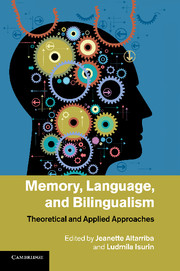Book contents
- Memory, Language, and Bilingualism
- Memory, Language, and Bilingualism
- Copyright page
- Contents
- Figures
- Tables
- Contributors
- Introduction
- 1 Bilingual memory:
- 2 Lexical competition in localist and distributed connectionist models of L2 acquisition
- 3 Working memory and (second) language processing
- 4 Working memory in simultaneous interpreters
- 5 Using electrophysiological measures to track the mapping of words to concepts in the bilingual brain:
- 6 Age effects in L2 learning:
- 7 Bilingualism, language, and aging
- 8 Crossovers and codeswitching in the investigation of immigrant autobiographical memory
- 9 Linguistic relativity and bilingualism
- 10 Testing effects for novel word learning in Chinese–English bilinguals
- 11 The lexicon in second language attrition:
- 12 Memory and first language forgetting
- 13 Future research directions:
- Index
12 - Memory and first language forgetting
Published online by Cambridge University Press: 05 November 2012
- Memory, Language, and Bilingualism
- Memory, Language, and Bilingualism
- Copyright page
- Contents
- Figures
- Tables
- Contributors
- Introduction
- 1 Bilingual memory:
- 2 Lexical competition in localist and distributed connectionist models of L2 acquisition
- 3 Working memory and (second) language processing
- 4 Working memory in simultaneous interpreters
- 5 Using electrophysiological measures to track the mapping of words to concepts in the bilingual brain:
- 6 Age effects in L2 learning:
- 7 Bilingualism, language, and aging
- 8 Crossovers and codeswitching in the investigation of immigrant autobiographical memory
- 9 Linguistic relativity and bilingualism
- 10 Testing effects for novel word learning in Chinese–English bilinguals
- 11 The lexicon in second language attrition:
- 12 Memory and first language forgetting
- 13 Future research directions:
- Index
Summary
Non-pathological first language forgetting is studied by socio- and psycholinguists. Psycholinguistic research relies on the same methodological approaches used in studies of bilingual memory. The present chapter gives a brief overview of theories, tasks, and findings pertaining to this domain of research. The reported empirical study contributes to the existing knowledge of first language (L1) attrition as well as shows a way in which the quantitative and qualitative methods of analysis can be used to provide deeper insight into bilingual memory. Three groups of Russian bilinguals with different second language backgrounds (English, Hebrew, and German) participated in a picture-naming study. Word frequency was found to be a decisive factor in L1 forgetting whereas the length of immigration proved only marginally reliable. Qualitative analysis of the data revealed retrieval failures at the semantic and word-form levels and showed how each of the second languages interfered with successful access of the L1 lexicon.
- Type
- Chapter
- Information
- Memory, Language, and BilingualismTheoretical and Applied Approaches, pp. 319 - 348Publisher: Cambridge University PressPrint publication year: 2012
- 2
- Cited by



